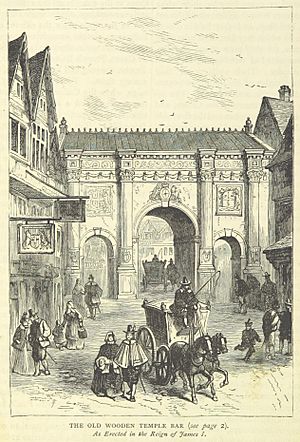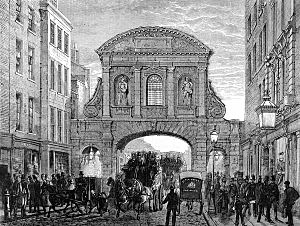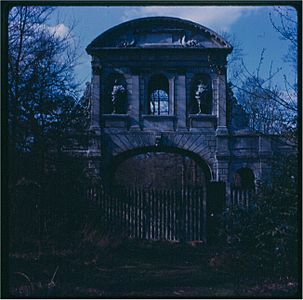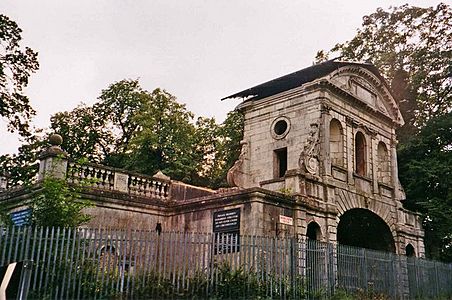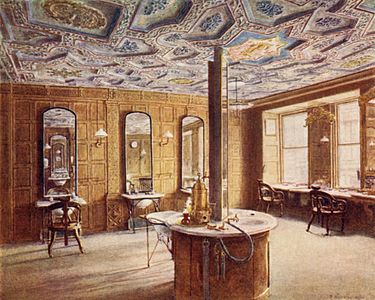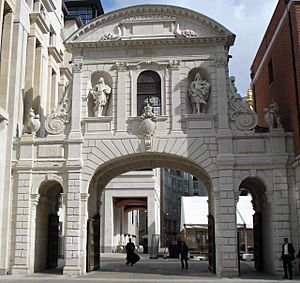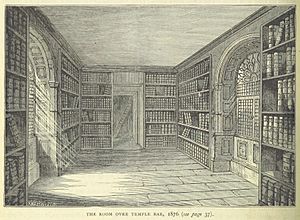Temple Bar, London facts for kids

Temple Bar was a very important entrance to the City of London from the City of Westminster. Imagine it as a special gate. In the old days, London grew beyond its walls. It set up gates called 'bars' on main roads. Temple Bar was next to an area called the Temple.
This gate was on the historic path used by kings and queens. They traveled from the Tower of London to the Palace of Westminster. These were two main homes for English monarchs long ago. The path also went from Westminster to St Paul's Cathedral. East of the gate, the road was Fleet Street. To the west, in Westminster, it was The Strand.
The City of London built a barrier here. This helped control trade coming into the City. Near Temple Bar, you can find the Royal Courts of Justice to the north. To the south is Temple Church. Also nearby are the Inner Temple and Middle Temple law schools.
Because it was such an important entrance, kings and queens would stop at Temple Bar. The Lord Mayor of London would meet them. He would offer the City's special sword as a sign of loyalty.
The name 'Temple Bar' first meant just a barrier across the road. But it also refers to a beautiful stone archway built in the 1600s. This archway, designed by Christopher Wren, stood there for 200 years. It was moved in 1878. Later, the Temple Bar Memorial was put in its place. This memorial has a dragon statue and statues of Queen Victoria and Edward VII.
Wren's original archway was saved. It was put back up in 2004 in the City. You can find it now in Paternoster Square, near St Paul's Cathedral. In 2022, the Duke of Gloucester officially opened the restored archway. It is now home to the Worshipful Company of Chartered Architects.
Contents
Why Temple Bar Was Important
In the Middle Ages, the City of London Corporation had power beyond the City's old walls. These areas were called the Liberties of London. To manage trade, barriers were built on major roads. These barriers were placed where the City's true border was far from its ancient wall gates.
Temple Bar was the most used of these barriers. This was because a lot of traffic passed through it. People traveled between the City of London, which was the main business center, and the Palace of Westminster, the political center. Temple Bar was located where Fleet Street meets The Strand today. This spot was outside London's old boundary wall.
Its name comes from the Temple Church. This church is next to the area to the south. The church gave its name to the wider area called the Temple. This area once belonged to the Knights Templar. Now, it is home to two famous law schools.
The special ceremony where the monarch stops at Temple Bar is well-known. It has appeared in art and books. People still talk about it during royal events today.
History of Temple Bar
Early Barriers and Events
A City barrier at The Temple was first mentioned in 1293. It was probably just a chain or a simple bar between posts. Later, more solid structures with arches were built. In 1351, a wooden archway was built. It even had a small prison above it.
The earliest record of Temple Bar is from 1327. It was about a legal case concerning a pathway in the area. In 1384, Richard II allowed the paving of Strand Street from Temple Bar to the Savoy Palace. Tolls were collected to pay for this work.
Many important events happened at Temple Bar. On November 5, 1422, the body of Henry V was carried to Westminster Abbey. Torch-bearers stood at every doorway from Southwark to Temple Bar. In 1503, the funeral procession of Elizabeth of York, wife of Henry VII, stopped at Temple Bar. The Abbots of Westminster and Bermondsey blessed her body there.
Anne Boleyn passed through the Bar on May 31, 1534. This was the day before her coronation. Temple Bar was newly painted and fixed for the occasion. Singers and children stood nearby. The Fleet Street water pipe even ran with claret wine!
In 1554, Thomas Wyatt the Younger led a rebellion. He was against Queen Mary I marrying Philip II of Spain. Wyatt fought his way to The Strand. Temple Bar was opened or forced open for him. But when he was pushed back, he was trapped by soldiers at Temple Bar. He surrendered there.
Wren's Famous Gate
The old gate at Temple Bar survived the Great Fire of London in 1666. However, it was decided to rebuild it. This was part of the big improvements made after the fire. King Charles II ordered the new gate. It is thought to be designed by Sir Christopher Wren.
The beautiful arch was built from Portland stone between 1669 and 1672. Thomas Knight and Joshua Marshall were the main builders. John Bushnell carved the statues.
The gate had two stories. It had one wide arch in the middle for road traffic. On each side, there were narrower arches for people walking. On the upper part, four statues celebrated the return of the Stuart kings in 1660. On the west side, you can see King Charles II and his father King Charles I. On the east side are King James I and Anne of Denmark.
For a long time, the heads of people found guilty of treason were sometimes displayed on the roof. This also happened on London Bridge. By the 1760s, the other seven main gates to London were torn down. But Temple Bar remained, even though it caused traffic problems. The room upstairs was rented to a bank, Child & Co, for storing their records.
People often complained about Temple Bar. Charles Dickens called it "that leaden-headed old obstruction." There were also jokes about it. For example, "Why is Temple Bar like a lady's veil? Both must be raised (razed) for 'busses' (buses)."
By 1874, parts of the gate were falling. The arches had to be held up with wood. More and more horse and cart traffic made Temple Bar a big bottleneck. This slowed down trade in the City. In 1878, the City of London Corporation decided to widen the road. They did not want to destroy such an old monument. So, they carefully took it apart piece by piece over 11 days. Its 2,700 stones were stored.
In 1880, a brewer named Henry Bruce Meux bought the stones. His wife, Valerie, Lady Meux, wanted the arch rebuilt. It was put back up as a new gatehouse in the park of their home, Theobalds Park in Hertfordshire. It stayed there in a forest clearing until 2003. A plaque now marks that spot.
-
Temple Bar Gate at Theobalds Park, 1968
The Gate's New Home
In 1938, Theobalds Park was sold. But the Temple Bar Gatehouse was kept by the Meux family. In 1984, the Temple Bar Trust bought it for £1. In 2001, the City of London decided to help pay for the gate to return to the City.
On October 13, 2003, the first stone was taken apart at Theobalds Park. All the stones were put on 500 pallets for storage. In 2004, it was brought back to the City of London. It was carefully rebuilt as an entrance to the Paternoster Square area. This is just north of St Paul's Cathedral. It opened to the public on November 10, 2004. The whole project cost over £3 million. Most of the money came from the City of London.
In September 2022, Temple Bar London was officially reopened. This includes the gateway and a building next to it. The Duke of Gloucester and the Lord Mayor of London Vincent Keaveny opened it. It is now home to a livery company, the Worshipful Company of Chartered Architects. It provides space for meetings, dining, and an education center.
Temple Bar Memorial
After Wren's gate was moved, Horace Jones designed a memorial. This memorial marks where Temple Bar used to stand. It was revealed in 1880. The Temple Bar Memorial stands in the street in front of the Royal Courts of Justice.
The fancy base holds a sculpture by Charles Bell Birch. It shows a dragon holding a shield with the City of London's arms. The base also has statues by Joseph Boehm. These are of Queen Victoria and her son, Edward VII. They were the last royals to pass through Wren's gate. This event is shown in one of the carvings on the memorial.
In the 1960s, smaller dragon sculptures were placed at other entry points to the City. Two of these were made in 1849 by James Bunstone Bunning. They were for the entrance to the Coal Exchange. They were moved to Victoria Embankment in 1962. The others are smaller versions of Bunning's design.
Temple Bar in Stories
Charles Dickens wrote about Temple Bar in his book A Tale of Two Cities. He mentioned it was near the fictional Tellson's Bank on Fleet Street. This bank was actually Child & Co., which used the rooms above Temple Bar for storage.
In Herman Melville's story The Paradise of Bachelors and the Tartarus of Maids, he talks about the Temple Bar gateway. He calls it a "Dantean Gateway." This is a reference to Dante's Inferno, where Dante describes the gate to Hell.
The dragon on top of the Temple Bar monument comes to life in Charlie Fletcher's children's book Stoneheart.
The dragon also appears in Virginia Woolf's book The Years. One character, Martin, points at the dragon. He thinks it looks "ridiculous" and "something between a serpent and a fowl."


